Minimum Spanning Trees Artificial Intelligence
- 1. DESIGN AND ANALYSIS OF ALGORITHM (CS206) MODULE-4 GREEDY METHOD
- 2. Greedy and other Design Approaches Introduction to Greedy using- - fractional knapsack problem - Huffman Code Minimum Spanning Tree- - Prim’s and Kruskal’s algorithms Single Source Shortest Paths- - Dijkstra’s and Bellman-Ford algorithms Introduction to Backtracking using - N-Queens problem, Introduction to Branch and Bound using - Assignment Problem or Traveling Salesman Problem.
- 6. Definition: Let G = (V, E) be an undirected connected graph. A subgraph t = (V, E’) of G is a spanning tree of G if and only if t is a tree. Example: Consider the complete graph of four vertices. Discuss various spanning trees possible over it.
- 7. Applications: • They can be used to obtain an independent set of circuit equations for an electric network. • Another application of spanning trees arises from the property that a spanning tree is a minimal subgraph G’ of G such that V(G’) = V(G) and G’ is connected. Any connected graph with n vertices must have at least n-1 edges and all connected graphs with n-1 edges are trees. If the nodes of G represent cities and the edges represent possible communication link connecting two cities, then the minimum number of links needed to connect the n cities is n-1. The spanning trees of G represent all feasible choices.
- 9. Approach: Build the spanning tree edge by edge. Question: How to choose the next edge? or What is the optimization criterion? Solution: Choose an edge that results in a minimum increase in the sum of the costs of the edges so far included. There are two possible ways to interpret this criterion.
- 10. Interpretation (01): The set of edges so far selected form a tree. Thus, if A = set of edges selected so far, then A forms a tree. The next edge (u, v) to be included in A should have property that A U {(u, v)} is also a tree. Question: Show that this selection criterion results in a minimum cost spanning tree. The corresponding approach is known as PRIM’S algorithm.
- 11. Approach- The algorithm starts with a tree that includes only a minimum cost edge of graph G. Then, edges are added to this tree one by one. The next edge (i, j) to be added is such that: i is already in partial spanning tree T j is not in the tree T. Cost(i, j) = minimum among all the edges (k, l) such that: k is in the tree T and l is not in the tree T. Key to this approach is to determine edge(I, j) efficiently.
- 12. Example:
- 13. Example:
- 14. Algorithm PRIM (C, n) { // Let G is a connected undirected graph, C is the cost adjacency matrix. // n is the number of vertices in G, T is the minimum weight spanning tree. for (i=1; I ≤ n; i++) visited[i] = 0; // Initialize all vertices as unvisited u = 1; // Consider vertex 1 as starting visited[u] = 1; T = ɸ // initially while (there is still unchosen vertex) { let <u, v> be the lightest edge between any chosen u and any unchosen v; visited[v] = 1; T = Union (T, <u, v>); // add edge to spanning tree } }
- 20. …
- 22. …
- 24. 2nd Interpretation: There is a second possible interpretation of the optimization criteria mentioned earlier in which the edges of the graph are considered in nondecreasing order of costs. This interpretation is that the set t of edges so far selected for the spanning tree be such that it is possible to complete t into a tree. Thus, t may not be a tree at all stages in the algorithm. This method is due to Kruskal.
- 25. Example:
- 26. // Early form of minimum-cost spanning tree algorithm due to Kruskal Algorithm: Kruskal 1. t = ɸ; 2. while ((t has less than n-1 edges) and (E ≠ ɸ)) do 3. { 4. Choose an edge (v, w) from E of lowest cost; 5. Delete (v, w) from E; 6. if (v, w) does not create a cycle in t then add (v, w) to t; 7. else discard (v, w); 8. }
- 27. Example:
- 28. Example:
- 29. …
- 30. …
- 31. …
- 32. …
- 33. …
- 34. …
- 36. Introduction: Two sets Si and Sj, i!=j, are said to be pairwise disjoint if there is no element that is in both Si and Sj. Example: Given n = 10, the elements can be partitioned into three disjoint sets, S1 = {1, 7, 8, 9} S2 = {2, 5, 10} and S3 = {3, 4, 6}
- 37. S1 = {1, 7, 8, 9} S2 = {2, 5, 10} and S3 = {3, 4, 6}
- 38. The operations we wish to perform on these sets are: (1) Disjoint set union: If Si and Sj are two disjoint sets, then their union Si U Si = all elements x such that x is in Si or Sj. In this process, the sets Si and Sj are replaced by Si U Sj in the collection of sets. (2) Find(i): Given the element i, find the set containing i. Thus, 4 is in set S3, and 9 is in set S1.
- 39. Union and Find operations:
- 40. S1 = {1, 7, 8, 9} S2 = {2, 5, 10} and S3 = {3, 4, 6}
- 41. How to implement Find (i) ? Algorithm SimpleFind (i) { while (P[i] >= 0) { i= P[i]; } return (i); }
- 42. How to implement operation Simple Union (i, j) ? We have two trees with roots i and j. Convention: First tree becomes a subtree of the second. The statement P[i] = j, accomplishes the Union.
- 43. …
- 44. …
- 45. Improved Union algorithm: Definition: [Weighting rule for Union(i, j)] If the number of nodes in the tree with root i is less than the number in the tree with root j, then make j the parent of i; otherwise make i the parent of j.
- 46. To implement the weighting rule, we need to know how many nodes there are in every tree. To do this easily, we maintain a count field in the root of every tree. If i is a root node, then count[i] equals the number of nodes in that tree.
- 47. Algorithm WeightedUnion (i, j) // Union sets with root i and j, i!= j, using the weighting rule. // p[i] = -count[i] and p[j] = -count[j]. { temp = p[i] + p[j]; if (p[i] > p[j]) then { // i has fewer nodes. p[i] = j; p[j] = temp; } else { // j has fewer or equal nodes. p[j] = i; p[i] = temp; } }
- 48. …
- 49. …
- 50. The maximum time required to perform a find (over tree obtained using WeightedUnion) is determined by the following lemma. Lemma 2.3: Assume that we start with a forest of trees, each having one node. Let T be a tree with m nodes created as a result of a sequence of union operations each performed using WeightedUnion.The height of T is no greater than[floor(lgm) + 1].
- 51. The following example shows that the bound of the lemma discussed in last slide is achievable for some sequence of unions. Example: Consider the behavior of WeightedUnion on the following sequence of unions starting from the initial configuration P[i] = -count[i] = -1. Here, 1 <= i<= 8 = n: Union(1, 2), Union(3, 4), Union(5, 6), Union(7, 8), Union(1, 3), Union(5, 7), Union(1, 5).
- 52. …
- 53. …
- 54. Performance Analysis: From the previous lemma 2.3, it follows that the time to process a find is O(logm) if there are m elements in a tree. If an intermixed sequence of u-1 union and f find operations is to processed, the time required = O(u + flogu), since no tree has more than u nodes in it. Of course, we need O(n) additional time to initialize the n-tree forest. [Even further improvement is possible. How?]
- 55. This time the modification is made in the find algorithm using the collapsing rule.
- 56. Collapsing Rule: If j is a node on the path from i to its root and P[i] != root[i], then set P[j] = root[i].
- 57. Given the tree below process the following eight finds: Sequence: Find(8), Find(8), Find(8), Find(8), Find(8), Find(8), Find(8), Find(8).
- 58. Case (1): SimpleFind is used
- 59. Case (2): When CollapsingFind is used
- 60. Algorithm CollapsingFind(i) // Find the root of the tree containing element i. // Use the collapsing rule to collapse all nodes from i to the root. { r = i; while (P[r] > 0) // Find the root r = P[r]; while (i != r) // collapse nodes from I to root r { s = P[i]; P[i] = r; i= s; } return r; }
- 61. …
- 62. …
- 63. …
- 64. …
- 65. Important: In the algorithms WeightedUnion and CollapsingFind use of the Collapsing rule roughly doubles the time for an individual find. However, it reduces the worst-case time over a sequence of finds. The worst-case complexity of processing a sequence of union and find using WeightedUnion and CollapsingFind is stated in Lemma 2.4.
- 66. This lemma makes use of a function α(p, q) that is related to a functional inverse of Ackermann’s function A(i, j). The function A(i, j) is very rapidly growing function. Consequently, α grows very slowly as p and q are increased. In fact, since A(3, 1) = 16, α(p, q) <= 3 for q < 216 = 65,536 and p >= q. Since A(4, 1) is a very large number and in our application q is the number n of set elements and p is n + f (f is the number of finds), α(p, q) <=4 for all practical purposes. Lemma 2.4:
- 67. Lemma 2.4: [Tarjan and Van Leeuwen] Assume that we start with a forest of trees, each having one node. Let T(f, u) be the maximum time required to process any intermixed sequence of f finds and u unions. Assume that u ≥ n/2. Then k1 [n + fα(f + n, n)] ≤ T(f, u) ≤ k2 [n + fα(f + n, n)] for some positive constants k1 and k2.
- 68. …


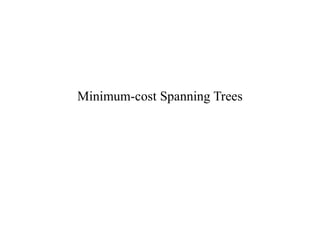


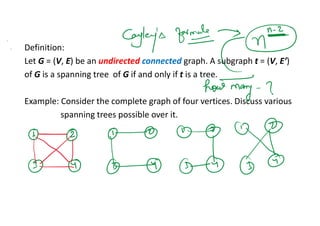







![Algorithm PRIM (C, n)
{
// Let G is a connected undirected graph, C is the cost adjacency matrix.
// n is the number of vertices in G, T is the minimum weight spanning tree.
for (i=1; I ≤ n; i++)
visited[i] = 0; // Initialize all vertices as unvisited
u = 1; // Consider vertex 1 as starting
visited[u] = 1;
T = ɸ // initially
while (there is still unchosen vertex)
{
let <u, v> be the lightest edge between any chosen u and any unchosen v;
visited[v] = 1;
T = Union (T, <u, v>); // add edge to spanning tree
}
}](https://image.slidesharecdn.com/minimumspanningtrees-250404191757-fa539675/85/Minimum-Spanning-Trees-Artificial-Intelligence-14-320.jpg)

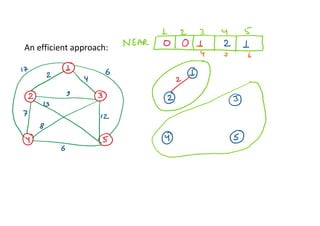







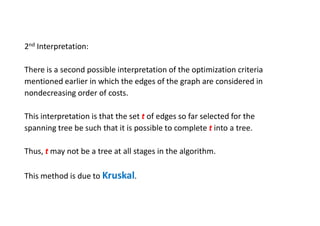











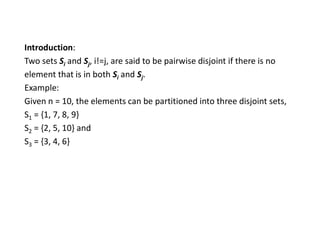




![How to implement Find (i) ?
Algorithm SimpleFind (i)
{
while (P[i] >= 0)
{
i= P[i];
}
return (i);
}](https://image.slidesharecdn.com/minimumspanningtrees-250404191757-fa539675/85/Minimum-Spanning-Trees-Artificial-Intelligence-41-320.jpg)
![How to implement operation Simple Union (i, j) ?
We have two trees with roots i and j.
Convention: First tree becomes a subtree of the second.
The statement P[i] = j, accomplishes the Union.](https://image.slidesharecdn.com/minimumspanningtrees-250404191757-fa539675/85/Minimum-Spanning-Trees-Artificial-Intelligence-42-320.jpg)
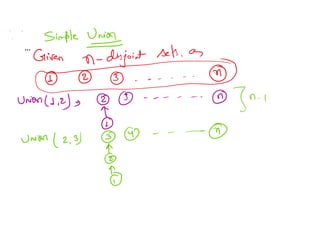

![Improved Union algorithm:
Definition: [Weighting rule for Union(i, j)] If the number of nodes in the
tree with root i is less than the number in the tree with root
j, then make j the parent of i; otherwise make i the parent
of j.](https://image.slidesharecdn.com/minimumspanningtrees-250404191757-fa539675/85/Minimum-Spanning-Trees-Artificial-Intelligence-45-320.jpg)
![To implement the weighting rule, we need to know how many nodes
there are in every tree.
To do this easily, we maintain a count field in the root of every tree.
If i is a root node, then count[i] equals the number of nodes in that
tree.](https://image.slidesharecdn.com/minimumspanningtrees-250404191757-fa539675/85/Minimum-Spanning-Trees-Artificial-Intelligence-46-320.jpg)
![Algorithm WeightedUnion (i, j)
// Union sets with root i and j, i!= j, using the weighting rule.
// p[i] = -count[i] and p[j] = -count[j].
{
temp = p[i] + p[j];
if (p[i] > p[j]) then
{
// i has fewer nodes.
p[i] = j; p[j] = temp;
}
else
{ // j has fewer or equal nodes.
p[j] = i; p[i] = temp;
}
}](https://image.slidesharecdn.com/minimumspanningtrees-250404191757-fa539675/85/Minimum-Spanning-Trees-Artificial-Intelligence-47-320.jpg)


![The maximum time required to perform a find (over tree obtained
using WeightedUnion) is determined by the following lemma.
Lemma 2.3: Assume that we start with a forest of trees, each having one
node. Let T be a tree with m nodes created as a result of a
sequence of union operations each performed using
WeightedUnion.The height of T is no greater than[floor(lgm)
+ 1].](https://image.slidesharecdn.com/minimumspanningtrees-250404191757-fa539675/85/Minimum-Spanning-Trees-Artificial-Intelligence-50-320.jpg)
![The following example shows that the bound of the lemma discussed in
last slide is achievable for some sequence of unions.
Example:
Consider the behavior of WeightedUnion on the following sequence of
unions starting from the initial configuration P[i] = -count[i] = -1.
Here, 1 <= i<= 8 = n:
Union(1, 2), Union(3, 4), Union(5, 6), Union(7, 8),
Union(1, 3), Union(5, 7),
Union(1, 5).](https://image.slidesharecdn.com/minimumspanningtrees-250404191757-fa539675/85/Minimum-Spanning-Trees-Artificial-Intelligence-51-320.jpg)


![Performance Analysis:
From the previous lemma 2.3, it follows that the time to process a find
is O(logm) if there are m elements in a tree.
If an intermixed sequence of u-1 union and f find operations is to
processed, the time required = O(u + flogu), since no tree has more
than u nodes in it.
Of course, we need O(n) additional time to initialize the n-tree forest.
[Even further improvement is possible. How?]](https://image.slidesharecdn.com/minimumspanningtrees-250404191757-fa539675/85/Minimum-Spanning-Trees-Artificial-Intelligence-54-320.jpg)

![Collapsing Rule:
If j is a node on the path from i to its root and P[i] != root[i], then set
P[j] = root[i].](https://image.slidesharecdn.com/minimumspanningtrees-250404191757-fa539675/85/Minimum-Spanning-Trees-Artificial-Intelligence-56-320.jpg)



![Algorithm CollapsingFind(i)
// Find the root of the tree containing element i.
// Use the collapsing rule to collapse all nodes from i to the root.
{
r = i;
while (P[r] > 0) // Find the root
r = P[r];
while (i != r) // collapse nodes from I to root r
{
s = P[i];
P[i] = r;
i= s;
}
return r;
}](https://image.slidesharecdn.com/minimumspanningtrees-250404191757-fa539675/85/Minimum-Spanning-Trees-Artificial-Intelligence-60-320.jpg)






![Lemma 2.4: [Tarjan and Van Leeuwen] Assume that we start with a
forest of trees, each having one node. Let T(f, u) be the maximum time
required to process any intermixed sequence of f finds and u unions.
Assume that u ≥ n/2. Then
k1 [n + fα(f + n, n)] ≤ T(f, u) ≤ k2 [n + fα(f + n, n)]
for some positive constants k1 and k2.](https://image.slidesharecdn.com/minimumspanningtrees-250404191757-fa539675/85/Minimum-Spanning-Trees-Artificial-Intelligence-67-320.jpg)
